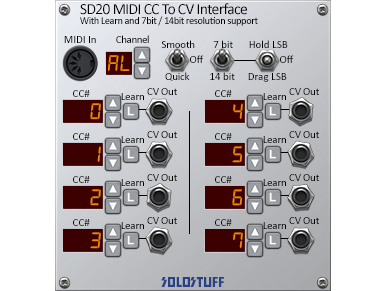Product Description
(This module is included in the System B)
The SD20 converts MIDI CC* messages to CV. Equipped with MIDI learn capability and hi resolution 14 bit support as well as the usual 7 bit support.
The channel LED selector specifies the MIDI channel listened to. The module has 8 sections for MIDI CC interfacing (conversion). CC values can be either changed manually or learned from incoming MIDI messages by pressing the “L” button besides each section. Notice that the module will not allow you to set the same CC number to two or more sections because thats practically useless as you can always take multiple cables from the same section. Also because this way internal CPU optimization is much better.
Smoothing can be applied using the Smooth/Quick/Off switch to reduce or eliminate the stepyness specially when using 7 bit resolution. Smooth is the smoothest but introduces a very slight lag, Quick is less smooth but the lag is less. Off turns off the smoothing. CV outputs always send values in EG range from 0V to 1V. To easily convert that to LFO range (-1V to 1V), you can use the SD902.
For 14 bit resolution to work. Your hardware MIDI controller must support it and must be configured to do so. A bit of understanding is required here to use it. Here is a brief description.
CC numbers range from 0 to 127. 7 bit MIDI uses all CC numbers. But in 14 bit MIDI, each 14 bit CC message is actually composed of two CC messages. An MSB (Course) and an LSB (Fine). MSB CC numbers range from 0 to 31 and LSB CC numbers range from 32 to 63. The rule is, if the sender sends an MSB CC of say 18 then the corresponding LSB CC must be 18+32=50 (We always add 32)**.
Technical Details
The following details are too technical and concern the Hold LSB/Drag LSB/Off. If you don’t want to bother, just put it to Off. It should work well most of the time.
14bit CC messages are sent using two messages, an MSB (course) and an LSB (fine). If there is a delay between the two messages, the receiver does not have the full value during that delay. Hence, the receiver should decide what to do with this half information while the remaining half is received. What complicates this further is that there doesn’t seams to be a defined standard as to which of the two messages is sent first!!. Some hardware controllers send MSB first, others send LSB first. The Hold LSB/Drag LSB/Off switch defines what to do in this case. When put on Off the SD20 will simply apply what ever messages it gets sent immediately on the current CC value and output that to CV. If you think of it for five minutes, you will figure out it should work but can cause very brief incorrect value jumps. The Drag LSB mode is designed to work better when the sender sends MSBs before LSBs, it temporarily changes the the current LSB value in a way that smooths transitions until the real LSB is received. The Hold LSB mode is designed to work better when the sender sends LSBs before MSBs. It saves the LSB value but never applies it to the output CV until the MSB is received. Note here that this mode will NOT work if the sender only sends LSBs, (like for example in compact mode in the SD12). The sender has to always send the pair for this mode to work.
*Control Change
**The remaining CC numbers from 64 to 127 will always work as 7 bit regardless of the mode chosen.


Reviews
There are no reviews yet.